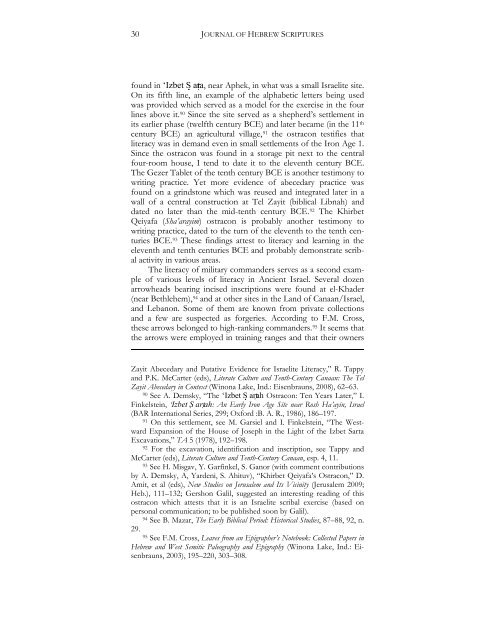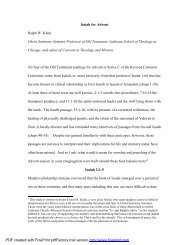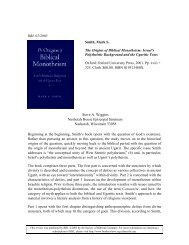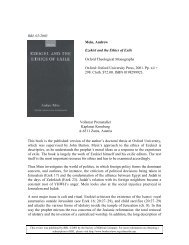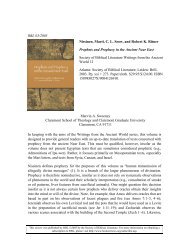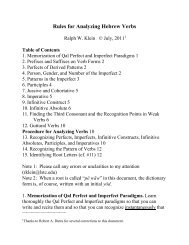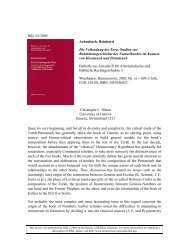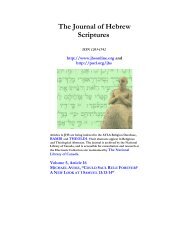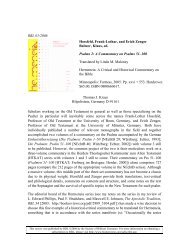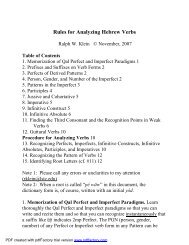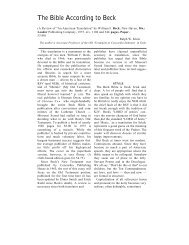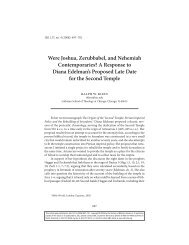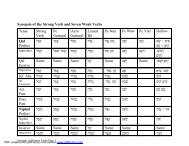The Book of Samuel: Its Composition, Structure and Significance as ...
The Book of Samuel: Its Composition, Structure and Significance as ...
The Book of Samuel: Its Composition, Structure and Significance as ...
You also want an ePaper? Increase the reach of your titles
YUMPU automatically turns print PDFs into web optimized ePapers that Google loves.
30 JOURNAL OF HEBREW SCRIPTURES<br />
found in ‘Izbet Ṣ arṭa, near Aphek, in what w<strong>as</strong> a small Israelite site.<br />
On its fifth line, an example <strong>of</strong> the alphabetic letters being used<br />
w<strong>as</strong> provided which served <strong>as</strong> a model for the exercise in the four<br />
lines above it. 90 Since the site served <strong>as</strong> a shepherd’s settlement in<br />
its earlier ph<strong>as</strong>e (twelfth century BCE) <strong>and</strong> later became (in the 11 th<br />
century BCE) an agricultural village, 91 the ostracon testifies that<br />
literacy w<strong>as</strong> in dem<strong>and</strong> even in small settlements <strong>of</strong> the Iron Age 1.<br />
Since the ostracon w<strong>as</strong> found in a storage pit next to the central<br />
four-room house, I tend to date it to the eleventh century BCE.<br />
<strong>The</strong> Gezer Tablet <strong>of</strong> the tenth century BCE is another testimony to<br />
writing practice. Yet more evidence <strong>of</strong> abecedary practice w<strong>as</strong><br />
found on a grindstone which w<strong>as</strong> reused <strong>and</strong> integrated later in a<br />
wall <strong>of</strong> a central construction at Tel Zayit (biblical Libnah) <strong>and</strong><br />
dated no later than the mid-tenth century BCE. 92 <strong>The</strong> Khirbet<br />
Qeiyafa (Sha’arayim) ostracon is probably another testimony to<br />
writing practice, dated to the turn <strong>of</strong> the eleventh to the tenth centuries<br />
BCE. 93 <strong>The</strong>se findings attest to literacy <strong>and</strong> learning in the<br />
eleventh <strong>and</strong> tenth centuries BCE <strong>and</strong> probably demonstrate scribal<br />
activity in various are<strong>as</strong>.<br />
<strong>The</strong> literacy <strong>of</strong> military comm<strong>and</strong>ers serves <strong>as</strong> a second example<br />
<strong>of</strong> various levels <strong>of</strong> literacy in Ancient Israel. Several dozen<br />
arrowheads bearing incised inscriptions were found at el-Khader<br />
(near Bethlehem), 94 <strong>and</strong> at other sites in the L<strong>and</strong> <strong>of</strong> Canaan/Israel,<br />
<strong>and</strong> Lebanon. Some <strong>of</strong> them are known from private collections<br />
<strong>and</strong> a few are suspected <strong>as</strong> forgeries. According to F.M. Cross,<br />
these arrows belonged to high-ranking comm<strong>and</strong>ers. 95 It seems that<br />
the arrows were employed in training ranges <strong>and</strong> that their owners<br />
Zayit Abecedary <strong>and</strong> Putative Evidence for Israelite Literacy,” R. Tappy<br />
<strong>and</strong> P.K. McCarter (eds), Literate Culture <strong>and</strong> Tenth-Century Canaan: <strong>The</strong> Tel<br />
Zayit Abecedary in Context (Winona Lake, Ind.: Eisenbrauns, 2008), 62–63.<br />
90 See A. Demsky, “<strong>The</strong> ‘Izbet Ṣ artah Ostracon: Ten Years Later,” I.<br />
Finkelstein, ‘Izbet Ṣ artah: An Early Iron Age Site near Rosh Ha’ayin, Israel<br />
(BAR International Series, 299; Oxford :B. A. R., 1986), 186–197.<br />
91 On this settlement, see M. Garsiel <strong>and</strong> I. Finkelstein, “<strong>The</strong> Westward<br />
Expansion <strong>of</strong> the House <strong>of</strong> Joseph in the Light <strong>of</strong> the Izbet Sarta<br />
Excavations,” TA 5 (1978), 192–198.<br />
92 For the excavation, identification <strong>and</strong> inscription, see Tappy <strong>and</strong><br />
McCarter (eds), Literate Culture <strong>and</strong> Tenth-Century Canaan, esp. 4, 11.<br />
93 See H. Misgav, Y. Garfinkel, S. Ganor (with comment contributions<br />
by A. Demsky, A, Yardeni, S. Ahituv), “Khirbet Qeiyafa’s Ostracon,” D.<br />
Amit, et al (eds), New Studies on Jerusalem <strong>and</strong> <strong>Its</strong> Vicinity (Jerusalem 2009;<br />
Heb.), 111–132; Gershon Galil, suggested an interesting reading <strong>of</strong> this<br />
ostracon which attests that it is an Israelite scribal exercise (b<strong>as</strong>ed on<br />
personal communication; to be published soon by Galil).<br />
94 See B. Mazar, <strong>The</strong> Early Biblical Period: Historical Studies, 87–88, 92, n.<br />
29. 95 See F.M. Cross, Leaves from an Epigrapher’s Notebook: Collected Papers in<br />
Hebrew <strong>and</strong> West Semitic Paleography <strong>and</strong> Epigraphy (Winona Lake, Ind.: Eisenbrauns,<br />
2003), 195–220, 303–308.


